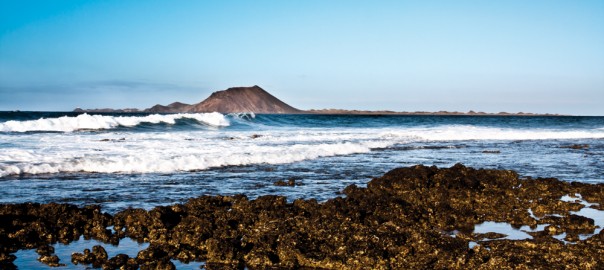It’s many those who ask us what are those fenced in excavations we find in Lobos islet, so we will leave this article for those who want to know a little about the history of our neighbour islet.
At the beginning of 2012 it was found out, in the islet of Lobos, a site with archaeological remains dating back to the I century B.C and the I century A.D.
In November 2013 the diggings in the islet started, by means of a project called “Poblamiento y Colonización en las Islas del Atlántico”, aimed to study and research of these remains, and framed within the existing institutional agreement between the OACM in Tenerife (Autonomous Organization of Centres and Museums) and the Regional Office of culture and historical patronage of the Council of Fuerteventura.
As studies and diggings have been developing, hypotheses have been made, and nowadays it is quite validated the one which states that the site belongs to Roman settlements, maybe just seasonal, looking for sea snails in the islet— Stramonita haemastoma or thais, known in the Canary Island as “carnadilla”—, from which they got the purple dye they used for the noblemen’s outfits at those times. What has allowed us to validate this hypotheses is the discovery of more than 70.000 specimens of these molluscs. This kind of site is the only discovery in the Canary Islands, and other similar sites have appeared in the island of Mogador and other points in the Atlantic African coastline, which proves that this route was already used by these great empires (Punic, Greek and Roman) to stock up not just on “carnadilla” for dyes but also on fish, as the area was really rich in tunidae.
In the old times, purple on fabrics was the only sign of social distinction, from the Phoenicians to the Romans, as getting this dye was very expensive. From each snail just a few drops of the coveted dye could be extracted, used to dye the capes and garments of the highest offices; so this dye was an indicator of luxury and social distinction. Even the State itself was in control of its monopoly and organized trade and military expeditions to find the necessary products for the elaboration of this dye, which they then brought for its trade in the Mediterranean.
Lobos Islet’s site has 108m2 (18 x 6), and excavations are making it deeper and deeper, as the remains which appear are on slopes and even part of the found walls are still under the earth, some 2m deeper. The hypotheses point out that the structures that are being dug up belonged to the rooms where they stored these molluscs. Some remains of pottery are also appearing, surely containers where they stored the molluscs, as well as remains of household and kitchen utensils, pieces of iron and bronze, fish hooks and nails, remains of amphoras, pans, lids… even bone remains from the animals of the time (sheep and goats).
Excavations are expected to take place until the end of 2016 and they are being carried out by a team of eight professionals coming from the council of Fuerteventura, from the OAMC in Tenerife and the ULL, who keep shedding light on the history of the ancient settlers and colonists of these lands.
Fuertecharter’s Team
